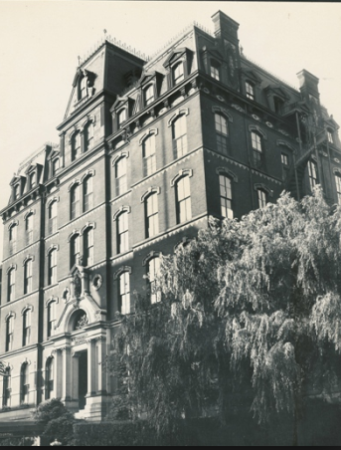I was delighted to see this exhibit at the Sacramento Museum. It is a great tribute to Catholic Sisters in America demonstrating how women religious effected and still impact life in the US from the 1700’s to modern times. Illustrations signify the beginning of the works of education, healthcare and social services which enrich the nation immeasurably. In 2005, approximately one in six hospital patients in the US were treated in a Catholic facility founded by Catholic Sisters.

Coming to America
From around the world many Sisters immigrated to America among whom was Mother Joseph Pariseau, a Sister of Providence (1823 – 1902). Her father boasted that she could drive a nail as well as any man. Presenting his daughter to the Sisters of Providence in 1843, he also predicted “She will make a good Superior some day.” He was right. By the time Mother Joseph died in 1902, she had supervised the construction of eleven hospitals, seven academies, five Indian schools and two orphanages. Mother Joseph was an immigrant who served immigrants. She and other Catholic Sisters played a significant role in the amalgamation of immigrants into American society.
Courage and Care
Nothing perhaps tests our faith and our courage, our strengths and our stamina like conflict, opposition and tragedies. Confronted with a Civil War, with hurricanes and tornadoes and with disasters like the Chicago fire and the San Francisco Earthquake, the metal of the Sisters of America was soon to be tested. The America of those days, was indeed a man’s world with women essentially confined to the home and child rearing and Sisters were not part of mainline society. This perception was drastically changed by the Sisters of America’s participation on both sides in the Civil War, where they nursed and cared for the wounded. History recalls the Sisters responding with zeal and courage to the various epidemics that hit the nation, and more than a hundred years after the fact, their contribution and response to the San Francisco Earthquake is still remembered.
The Sisters gained respect and admiration for their faith filled attitudes, their courage, patience and calmness under pressure, and a certain simplicity that put others at ease. Writing about the smallpox epidemic that was caused to spread by the World’s Fair held in Chicago in 1893, Mother Austin Carroll rsm, wrote “Not a bell rang, not a note of music, the very songbirds have deserted us.” It seems no adversity was too great for the Sisters of America.
Service and Leadership
While pursuing a personal calling, women religious built an enduring public legacy. Their works paralleled the nation’s expansion, requiring them to staff, lead and administer large institutions at a time when few women worked outside the home. To be better teachers, Sisters pursued advanced degrees and founded women’s colleges. Similarly, to raise the bar in healthcare, they initiated nurses training programs.
A section of the exhibit illustrates how Sisters continued to grow professionally and in the process educated others as well, particularly in the fields of education, healthcare and social service.
The New York Foundling Home

The New York Foundling Home was established in 1869 and still serves families today. On a Fall night in 1869, a baby girl greeted three Sisters of Charity in New York. Left on their doorstep as they scrubbed and readied their new convent. “Sarah H.” became the first of several hundred thousand children cared for by the New York Foundling Home. To heat the facility, the Sisters begged for wood and coal. Now in the 21st century, the New York Foundling Home continues its mission to shelter children and help families in crisis.
The Mayo Clinic
In 1883, a violent tornado razed the small farming community of Rochester, Minnesota. The ensuing devastation inspired Mother Alfred Moes, O.S.F. to do more than simply rebuild. She proposed to Dr. William May and his sons that she would build and staff a hospital if they would agree to provide the medical care. This collaboration was a significant milestone in the development of what is now known as Mayo Clinic.
During the early 1900’s, as hospitals evolved from almshouses for the destitute into medical institutions, Sisters anticipated future needs. As healthcare changed, so did the Sisters. They modified their habits to accommodate patient care and established nurse education programs. On a Fall day in 1906, a Wisconsin farm girl, Mary Evaline Wolff, arrived by horse drawn carriage at St. Mary’s College in South Bend, Indiana. Later Sister Madeleva Wolff recalled thinking to herself “If this makes a difference in my life, I shall always remember it”. Madeleva emerged as an outstanding leader in the field of higher education, launching the nation’s first graduate theology program for women.
The last part of the exhibit demonstrates how the ministries of the Catholic Sisters in America have grown, evolved and found new expression in meeting the needs of modern society. In recent decades the Sisters in America have portrayed great flexibility and resilience in updating and adapting themselves to new challenges. The progress that they have made in this way, can be seen especially in the areas of social service, education and medicine. In truth the Sisters have responded positively to the call of the Second Vatican Council to rediscover the original visions of their Foundresses, to broaden their horizons and to reach out to the modern world.
A notable dimension of the “Sisters in America” story is the fact that many sisters from America are now missionary Sisters around the world. Some of their stories are well known, such as the Sisters who were murdered for their zeal and work in places like El Salvador, Libya and Brazil.
Conclusion
By way of conclusion, over the three hundred years since Catholic Sisters first came to what is today the United States 220,000 women and over 650 communities have served in this country. The exhibit honors those often nameless and faceless sisters who made a path by walking. This is not the end of the story but the opening of a yet- to – be revealed chapter in the ongoing evolution of the lives of Catholic Sisters. Like the Ursulines in 1727, those living in this moment do not try to figure out what role they will play in history – they simply read the signs of the times and find ways to respond in the here – and – now.
Kathleen O’Dwyer rsm
US Province


